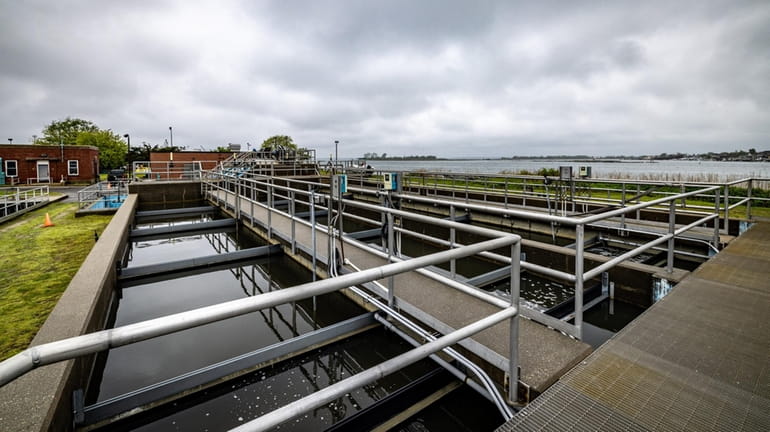Wastewater treatment providers would test for 'forever chemicals' under new guidelines

New proposed guidelines would require wastewater treatment providers to sample for “forever chemicals” as part of an ongoing effort to limit the compounds in the environment. Credit: Newsday/J. Conrad Williams Jr.
The state Department of Environmental Conservation is proposing new guidelines requiring wastewater treatment providers to sample for “forever chemicals” as part of an ongoing effort to limit the compounds in the environment.
If adopted, the guidelines would provide the agency with data on how much 1,4-Dioxane and PFAS — often called forever chemicals because they don’t easily break down —are being discharged from publicly-owned facilities like sewage treatment plants.
Facilities with permits for a state pollutant discharge elimination system would be affected by the guidelines and could face new requirements as a result. When levels of the pollutants exceed the state's standard, the DEC would decide how to most effectively and cost-efficiently abate them.
“Supporting the state’s overall strategy to reduce these contaminants in our environment, DEC’s initial objective is to understand the level of emerging contaminants that sewage treatment plants are dealing with,” said Alexander Smith, assistant division director for the DEC’s Division of Water. “The next objective is to determine how to reduce contaminants from these specific types of publicly owned treatment facilities with exceedances through pollutant minimization programs.”
PFAS are a group of chemicals used in nonstick and water-resistant products, and 1,4-Dioxane has historically been used as a solvent stabilizer in shampoos, cleaning products and detergents. Studies have shown exposure to PFAS may damage the reproductive and endocrine systems and have other health impacts. The U.S. Environmental Protection Agency has classified 1,4-Dioxane as a probable human carcinogen.
Water treatment plants generally don’t manufacture the chemicals but can accept wastewater from facilities that do. The EPA in December 2022 recommended that water treatment facilities test for PFAS quarterly.
Last year the DEC issued guidance for industrial sources that discharge directly into the environment. On Long Island, those include laundromats and other facilities.
It is not clear whether the new regulations would affect sewer district ratepayers. Wastewater treatment providers are monitoring how they will impact finances.
“We have to see what the state's going to decide and how it's going to be instituted,” said Windsor Kinney, superintendent of the Port Washington Pollution Control District which serves about 28,000 residents and businesses. “It'll definitely affect the tax base if we have to increase treatment or install something new.”
In 2020 New York adopted the nation’s first limit on 1,4-Dioxane in drinking water, at 1 part per billion as well as a limit of 10 parts per trillion for PFOS and PFOA, two of the most pervasive PFAS compounds. Long Island drinking water providers have relied on increased rates, new surcharges and state aid to fund the infrastructure needed to meet those requirements.
Robert Hayes, director of clean water at the Albany-based nonprofit Environmental Advocates NY, noted the guidelines prioritize action at treatment plants that discharge into drinking water sources. He said environmentalists are also concerned about discharge into non-drinking water sources.
“There is no safe level of exposure to these chemicals,” he said. “Those chemicals could impact fish populations that people might be consuming in that area and exposed to PFAS in that way.”
The details are available on the DEC website. Public comment will be accepted until Feb. 9.
The state Department of Environmental Conservation is proposing new guidelines requiring wastewater treatment providers to sample for “forever chemicals” as part of an ongoing effort to limit the compounds in the environment.
If adopted, the guidelines would provide the agency with data on how much 1,4-Dioxane and PFAS — often called forever chemicals because they don’t easily break down —are being discharged from publicly-owned facilities like sewage treatment plants.
Facilities with permits for a state pollutant discharge elimination system would be affected by the guidelines and could face new requirements as a result. When levels of the pollutants exceed the state's standard, the DEC would decide how to most effectively and cost-efficiently abate them.
“Supporting the state’s overall strategy to reduce these contaminants in our environment, DEC’s initial objective is to understand the level of emerging contaminants that sewage treatment plants are dealing with,” said Alexander Smith, assistant division director for the DEC’s Division of Water. “The next objective is to determine how to reduce contaminants from these specific types of publicly owned treatment facilities with exceedances through pollutant minimization programs.”
PFAS are a group of chemicals used in nonstick and water-resistant products, and 1,4-Dioxane has historically been used as a solvent stabilizer in shampoos, cleaning products and detergents. Studies have shown exposure to PFAS may damage the reproductive and endocrine systems and have other health impacts. The U.S. Environmental Protection Agency has classified 1,4-Dioxane as a probable human carcinogen.
Water treatment plants generally don’t manufacture the chemicals but can accept wastewater from facilities that do. The EPA in December 2022 recommended that water treatment facilities test for PFAS quarterly.
Last year the DEC issued guidance for industrial sources that discharge directly into the environment. On Long Island, those include laundromats and other facilities.
It is not clear whether the new regulations would affect sewer district ratepayers. Wastewater treatment providers are monitoring how they will impact finances.
“We have to see what the state's going to decide and how it's going to be instituted,” said Windsor Kinney, superintendent of the Port Washington Pollution Control District which serves about 28,000 residents and businesses. “It'll definitely affect the tax base if we have to increase treatment or install something new.”
In 2020 New York adopted the nation’s first limit on 1,4-Dioxane in drinking water, at 1 part per billion as well as a limit of 10 parts per trillion for PFOS and PFOA, two of the most pervasive PFAS compounds. Long Island drinking water providers have relied on increased rates, new surcharges and state aid to fund the infrastructure needed to meet those requirements.
Robert Hayes, director of clean water at the Albany-based nonprofit Environmental Advocates NY, noted the guidelines prioritize action at treatment plants that discharge into drinking water sources. He said environmentalists are also concerned about discharge into non-drinking water sources.
“There is no safe level of exposure to these chemicals,” he said. “Those chemicals could impact fish populations that people might be consuming in that area and exposed to PFAS in that way.”
The details are available on the DEC website. Public comment will be accepted until Feb. 9.

